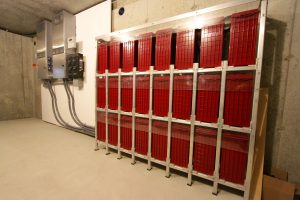By David Dodge and Duncan Kinney

Elon Musk on stage presenting the Powerwall. Photo courtesy the General Physics Laboratory
There are not many entrepreneurs who can command a room like Elon Musk. When he stepped onto a stage in May to unveil the Powerwall, the audience oohed and ahhed and dutifully pre-ordered more than 38,000 of Tesla’s new home battery systems.
And while Tesla gets the headlines, other energy storage players shouldn’t be jealous. Musk just gave the nascent industry a billion dollars worth of free press. And in Canada it’s Ontario that’s leading the way in deploying energy storage systems in the field. While the Tesla Powerwall won’t be available to the public until next year, Panasonic Eco Solutions and a couple of other partners are doing an interesting pilot project in Oshawa.
They’re installing 30 systems that combine solar PV and batteries: a six-kilowatt solar system with batteries that can store up to 10 kilowatt-hours.
“Most utilities see storage as something that is coming. Oshawa Power is being very progressive and trying to learn more about the technology, how it’s going to interface with their grid and how customers are going to use it,” says Sylvie Briz of Panasonic Eco Solutions.

Sylvie Briz, Director of Marketing and Business Development and residential storage at Panasonic. They are doing pilot projects in Oshawa, Ontario and Australia already. Photo David Dodge, GreenEnergyFutures.ca
Without all the hoopla, Panasonic has also started pilot projects in Australia. They’re installing eight-kilowatt-hour lithium ion battery storage systems that can provide two kilowatts of electricity in homes. The system is scaled for a five-kilowatt home solar system and can help double the home’s rate of self-consumption of solar electricity.
And deployment really is the key. No one knows what niche energy storage is going to fill in the energy market until it’s deployed in sufficient numbers.
“The fact is that storage can play in dozens of different areas of the electricity market, whether it’s just providing backup, whether it’s time shifting, whether it’s bulk storage for holding wind energy — when the wind’s blowing and we don’t need it — or solar energy when we want to deploy it at a later time. Whether it’s just doing voltage regulation or grid regulation. Sorting it out and coming up with rules once they nail that, I think it’s going to open up this whole world of innovation,” says Tyler Hamilton, editor of Corporate Knights magazine.
Ontario is testing a range of battery applications. They’ve funded 34 megawatts worth of projects with the technologies ranging from batteries to flywheels to even hydrogen and thermal storage.
Ontario plans to roll out 50 megawatts of energy storage and while it doesn’t compare to California’s pledge to install 1,300 megawatts, it’s still a very good start.
And if you are confused about using megawatts to describe a battery system, you are not alone. Utilities and governments use megawatts as a matter of habit and familiarity, while battery manufacturers typically use the more accurate term megawatt- (or even gigawatt-) hours. Read this article for a better breakdown.
The energy storage end game is residential
While utility-scale projects are the ones getting big dollars right now, if storage goes big, it will be because of the residential market.
Jason Rioux is a vice-president at NRStor, an energy storage company in Ontario. They’re involved in a two-megawatt flywheel project featuring Temporal Power’s technology, but they’ve also partnered up with Tesla to sell and deploy their residential and commercial products.
“The closer you get to the load, the more value you can deliver to rate payers, and so we see a lot of opportunity for grid scale projects to solve grid scale problems. But we also see residential projects distributed out amongst all of the load centers across the province or across the country to be able to deliver significant benefit back to the system,” says Rioux.

Reid’s Heritage Homes included a 3-day battery backup system in their first net-zero home to try it, see it, cost it out and validate it. Their second net-zero home will not have batteries because the economics aren’t right at this time says the company. Photo David Dodge, GreenEnergyFutures.ca
“This is just the beginning. The cost of these technologies will continue to decrease and be more economic to more people.”
In management circles it’s called the experience curve and it’s a real thing. More manufacturing capacity brought the price of solar modules way down, and the same thing will happen to batteries. Tesla is building Gigafactory One in the Nevada desert right now. It will be the world’s largest battery factory at 10 million square feet and costing $5 billion. And at full manufacturing capacity it will be able to pump out 50 gigawatt-hours worth of batteries a year.
But it’s not just storage that’s going to change how our energy system works. A whole suite of next-generation energy services are set to come online. John Gorman, the president of the Canadian Solar Industries Association, sketched out the best vision of this future that we’ve heard yet.
“I’ll just tell you how personally excited I am about a future that is literally right around the corner. When you look at Ontario, for example, where you’re a home owner who has solar on their rooftop, a storage battery in your garage, a smart meter on the side of your house, an electric vehicle in the garage, and smart apps on your telephone that allow you to control your appliances, you can manage your electricity needs in the most cost effective way and help make the overall electricity system more resilient and better for everybody,” says Gorman.
And when established companies are making big bets on storage over natural gas peaker plants you know you’ve hit a tipping point. Energy storage is going to change everything.


